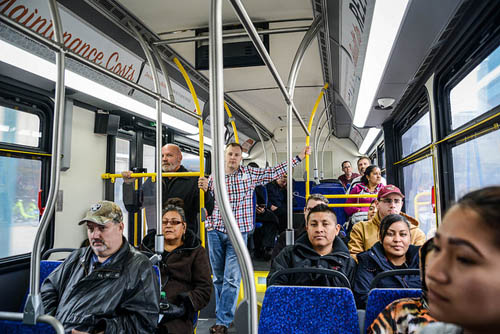Metro Transit has been providing low-income residents with rides for just $1 under a six-month pilot study and concluded that the program deserves a larger demonstration project, to begin this fall.
Metro Transit hopes it can eventually establish a more permanent program across the region with funding to support it.
The pilot project resulted from discussions about equity identified in the region’s long-range development guide, Thrive MSP 2040, adopted by the Council in 2014.
Project goal: Reduce transit barriers for low-income residents
 Project Manager Mary Capistrant said the pilot was developed to reduce transit barriers for low-income residents regardless of their age, ability, language proficiency or demographic.
Project Manager Mary Capistrant said the pilot was developed to reduce transit barriers for low-income residents regardless of their age, ability, language proficiency or demographic.
“We achieved most of our goals and were pleased with the results and comments we received from the nearly 300 riders who participated,” Capistrant said. “They are a passionate group who rely on transit not only for essentials like work, education and medical appointments, but also to stay connected with family and friends and social supports.”
Revenue Operations Manager Nick Eull said Metro Transit’s goal ultimately is to develop a direct relationship with low-income riders, in addition to maintaining relationships with agency partners that also link low-income residents with transit programs.
Subsidy gives residents ‘wiggle room’ for groceries, other needs
In the original pilot project, Metro Transit partnered with the Metropolitan Council’s Housing Redevelopment Authority (aka Metro HRA) to identify qualifying low-income residents.
The $1 fare program was offered to 4,000 households – more than 8,000 people – and 287 signed up. Nearly 15,000 rides were taken, most during non-rush hours, though there was no restriction on time of day for travel.
Those enrolled rode the bus more often and were glad to save on transit costs. One woman from Saint Paul who has relied completely on transit for 20 years said she “gets a lot more accomplished when I don’t have to worry about digging up $3.” A man from Roseville who is working on his GED said, “Now I have more wiggle room for groceries or toiletries.”
One shortfall of the pilot was the comparatively low number of enrollees, making data analysis difficult to predict future impacts. Capistrant said Metro Transit and Metro HRA staff did extensive outreach but learned that the website was a barrier to participation for many in the group, and they need more face-to-face contact.
To attract more riders in the next phase of the work, staff will be reaching into the low-income community through the agency’s many partnerships.
Larger demonstration project begins October 2016
A new pilot project that will begin this fall and conclude after six months will be capped at 3,000 participants.
Riders can sign up at Metro Transit stores and other sites to be determined ijointly with community partners – locations like busy community centers, social service agencies, and large housing complexes that serve low-income residents.
Metro Transit is working with partners to develop a list of common documents from other agencies that have already verified low-income status of residents, such as a SNAP/food stamp card. The holder can present that to qualify for enrollment.
The larger demonstration will provide a better look at the need for transit assistance in the region. It also will help Metro Transit improve its planning for revenue streams toward a potential full implementation of the program.